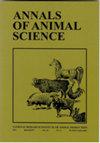在断奶日粮中添加水飞蓟素、水飞蓟提高了双颌海鲈的成活率、生长、抗氧化能力和脂肪酸谱
IF 1.9
4区 农林科学
Q1 Veterinary
引用次数: 7
摘要
为了维持正常发育、高存活率和快速生长,海洋鱼类幼鱼需要富含多不饱和脂肪酸的饲料,以降低活性氧积累的风险。为此,本试验旨在研究在断奶饲料中添加水飞蓟素(SM)对欧洲鲈鱼(Dicentrarchus labrax)幼虫生长性能、存活率、抗氧化酶活性和脂肪酸组分的影响。采用SM水平分别为0、200、400和600 mg kg - 1 (SM 0.00、SM 200、SM 400和SM 600)的4种等氮等脂饲料进行试验。结果表明,以剂量依赖的方式,增加饲粮中SM水平可提高成活率、生长和饲料利用率。与对照组相比,SM 600组增重、成活率和饲料系数分别提高了123.21%、11.66%和38.72%。剂量-反应分析表明,SM水平与体重增加呈显著正相关(R2=0.96),与FCR呈显著负相关(R2=0.88)。饲粮中添加sm的幼虫抗氧化酶活性显著高于对照组。与对照组相比,SM600组的CAT和SOD分别提高了81.77%和5.08%。此外,饱和脂肪酸含量降低,不饱和脂肪酸含量升高,其中SM600组表现得尤为明显。综上所述,断奶期在微饲料中添加600 mg kg−1的SM可提高欧洲鲈鱼幼鱼的生长、存活率、抗氧化能力和脂肪酸谱。本文章由计算机程序翻译,如有差异,请以英文原文为准。
Silymarin, Silybum marianum, Supplemented Weaning Diet Boosted Survival, Growth, Antioxidant Status, and Fatty Acids Profile of Seabass, Dicentrarchus labrax
Abstract To sustain normal development, high survival, and rapid growth, marine fish larvae require a diet rich in polyunsaturated fatty acids, which could decrease the risk of reactive oxygen species accumulations. Consequently, a 60-day feeding experiment was conducted to determine the effect of silymarin (SM) supplementation in weaning diets on the growth performance, survival, antioxidant enzyme activities, and fatty acids profile of European seabass ( Dicentrarchus labrax ) larvae. Four isonitrogenous and isolipidic diets were investigated using SM at levels of 0, 200, 400, and 600 mg kg −1 (SM 0.00 , SM 200 , SM 400 , and SM 600 , respectively). The findings showed that, in a dose-dependent manner, increasing dietary levels of SM enhanced survival, growth, and feed utilization. In the SM 600 group, the weight gain, survival, and feed conversion ratio (FCR) improved by 123.21, 11.66, and 38.72%, respectively, compared to the control group. The dose-response analysis demonstrated a strong positive correlation (R2=0.96) between SM levels and weight increase, and a strong negative correlation (R2=0.88) between SM levels and FCR. The antioxidant enzyme activities of larvae given SM-enriched diets were significantly greater than those of the control group. Compared to the control group, the CAT and SOD improved by 81.77 and 5.08% in the SM600 group. In addition, the saturated fatty acid content decreased while the unsaturated fatty acid content increased, particularly in the SM600 group. The results indicate that supplementing the micro diet of European seabass larvae during weaning with SM at a dose of 600 mg kg −1 increases growth, survival, antioxidant status, and fatty acid profiles.
求助全文
通过发布文献求助,成功后即可免费获取论文全文。
去求助
来源期刊

Annals of Animal Science
AGRICULTURE, DAIRY & ANIMAL SCIENCE-
CiteScore
3.80
自引率
5.30%
发文量
138
期刊介绍:
Annals of Animal Science accepts original papers and reviews from the different topics of animal science: genetic and farm animal breeding, the biology, physiology and reproduction of animals, animal nutrition and feedstuffs, environment, hygiene and animal production technology, quality of animal origin products, economics and the organization of animal production.
 求助内容:
求助内容: 应助结果提醒方式:
应助结果提醒方式:


